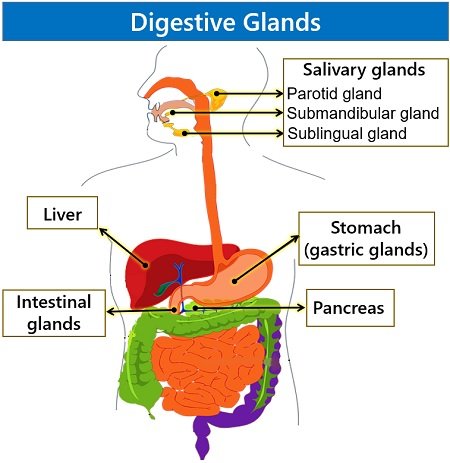MCQ ON DIGESTIVE GLANDS class 12 for NEET | DIGESTIVE GLANDS class 12 | MCQ DIGESTIVE GLANDS with Answer | Check the below NCERT MCQ question for class 12 Biology based on the with Answers.
MCQ on DIGESTIVE GLANDS class 12 Biology with answers were prepared based on the latest pattern.We have provided class 12 Biology MCQs question with Answers to help students understand the concept very well.

MCQ ON DIGESTIVE GLANDS class 12 for NEET
MCQ ON DIGESTIVE GLANDS is useful for NEET / CSIR / UGC / CBSE / ICSE / AIIMS / EXAM / AFMC EXAM / STATE LEVEL MEDICAL EXAM/ KVS PGT BIOLOGY / NVS PGT BIOLOGY EXAM 2022-2023,2024
INTRODUCTION:-
DIGESTIVE GLANDS
The human digestive glands include salivary gland, gastric glands, liver, Pancreas and intestinal glands.
1.Salivary glands :- There are three pairs of salivary glands:
Parotid glands, sublingual glands and submaxillary glands or submandibular
Parotid glands:-These are the largest salivary glands.They lie on the sides of the facts , just below and infront of the ears.
Sublingual glands:- Thes lie under the front part of the tongue.The sublingual ducts ,also termed as ductus of Rivinus also open under the tongue.
Submaxillary glands:-
These lie at the angles of lower jaw.The submaxillary ducts also known as Wharton’s ducts , open under the tongue.
The salivary glands secrets a viscous fluid called saliva.It contains water, salts , mucin and an enzyme salivary amylase or ptyalin. Its pH is nearly neutral being 6.7.
The slavery glands are under neural control, Salivation is activated by the sight , smell ,idea and talk of food and by the presence of food in the buccal cavity.
Functions of saliva:- It moistens and lubricates the buccal mucosa, tongue and lips.
It also moistens food and changes it to semi solid mass for easy swallowing.
Gastric glands:-the gastric glands are microscopic simple tubular glands In the wall of stomach. They have three more common types of gland cells.
Peptic cells that are usually basal in location and produce enzymes.
Oxyntic cells that secret HCl.
Mucous cells which add mucus.
The three secretions together form an acidic gastric juice pH 2. It is discharged into the stomach.
Liver:- Liver is the largest gland in the body. It consists of two main lobes:
Large right lobe and much smaller left lobe.Two small lobe called quadrate lobe.
Liver consists of small structural and functional unit called lobules.Kupffer cells are found in liver.
Pancreas:-
The pancreas is an elongated yellowish gland lying partly behind the stomach in the abdomen.It consists of head, body and tail.
Intestinal glands:-
The intestinal glands are numerous and microscopic .They lie in the wall of the small intestine.
They are of 2 types :-
crypts of Lieberkuhn and Brunner’s glands.
Mucous glands:- The mucous glands lubricates the digestive tract so that food slips through it easily.This prevent injury to the delicate mucous membrane.
MCQ THE DIGESTIVE GLANDS class 12 for NEET/KVS PGT BIOLOGY / NVS PGT BIOLOGY EXAM 2022-2023,2024
1. The largest salivary glands is
(a) parotid gland
(b) sublingual gland
(c) submaxillary gland
(d) gastric glands
Ans (a) parotid glands
2. Parotid glands is also called
(a) stensen’s ducts
(b) sublingual gland
(c) submaxillary glands
(d) all the above
Ans. (a) stensen’s ducts
3. The glands lie under the front part of the tongue.
(a) sublingual glands
(b) parotid glands
(c) submaxillary glands
(d) all the above
Ans. (a) sublingual glands
4. The salivary glands secrets a viscous fluid contains an enzyme
(a) salivary amylase
(b) ptyalin
(c) both
(d) none of these
Ans.(c) both a and b
5. The cells that secret HCl
(a) mucous cells
(b) oxyntic cells
(c) peptic cells
(d) all the above
Ans.(b) oxyntic cells
6. The glands which is known as Wharton’s ducts.
(a) parotid glands
(b) sublingual glands
(c) submaxillary glands
(d) none of these
Ans.(c) submaxillary glands
7. The glands lie at the angles of the lower jaw.
(a) Submaxillary glands
(b) Sublingual glands
(c) parotid glands
(d) none of the above
Ans.(a) submaxillary glands
8. Acidic gastric juice with pH is
(a) 2
(b) 3
(c) 4
(d) 5
Ans.(a) 2
9. The parietal cells also secret the Castle’s intrinsic gastric factor that help in the absorption of vitamin
(a) vitamin B2
(b) vitamin B12
(c) vitamin C
(d) vitamin D
Ans. (b) vitamin B12
10. Liver consists of small structural and functional units called
(a) pleura
(b) lobules
(c) fundus
(d) mucosa
Ans. (b) lobules
11. Kupffer cells found in
(a) liver
(b) small intestine
(c) large intestine
(d) all the above
Ans.(a) liver
12.The pancreatic juices contains sodium bicarbonate proenzymes
a) trypsinogen
b) chymotrypsinogen
c) procarboxypeptidases
(d) all of these
Ans . (d) all of these
13. Brunner’s glands are present in
(a) liver
(b) small intestine
(c) large intestine
(d) duodenum
Ans.(d) duodenum
14. The contraction of gall bladder is due to
(a) Gastrin
(b) Secretion
(c) Cholecystokinin
(d) Enterogastrone
Ans. (c) Cholecystokinin
15.The hormone that stimulates the stomach to secrete gastric juice is
(a) Gastrin
(b) Rennin
(c) Enterokinase
(d) Enterogastrone
Ans.(a) Gastrin
ALSO READ:-
● YOU CAN WATCH BIOLOGY SIR Youtube channel
16. The function of ductus choledochus is to carry
(a) ova
(b) bile
(c) urine
(d) sperms
Ans.(b) bile







Leave a Comment